The portulacaria afra is known by many names, for example, even way down in South Africa, where they are native, they have a few names: spekboom, or porkbush, or even elephants food. In the succulent community they call it (inexplicably) dwarf jade, even though it can grow into a small tree.
In bonsai, some people call it “not-a-bonsai”. We shall not name names nor shame those mutterers much more than necessary. 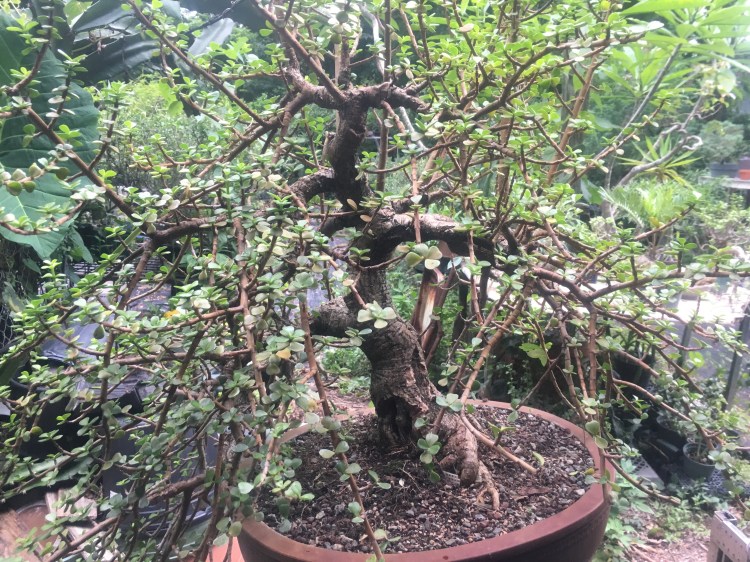
As you can probably guess from this post (and all the other Posts I’ve written with portulacaria as the subject) , I believe it’s a valid bonsai subject (and it’s really just a matter of taste whether a person thinks one plant can be a bonsai or not. My criteria, if you can make it look like a tree, then it’s valid. Period. Bonsai is the art of making a small plant or tree look like a big and old tree. You can argue all you want about woody stems or Japan, but bonsai has entered the Art World and that means it can and will change. Sorry guys) . And besides, there’s no accounting for taste, I mean, as an example, who even likes lima beans?
This particular tree came from a friend down in the Palm Beaches. He is having me develop it while he does some serious land improvement on his property.
I’ve been allowing it to grow and get healthy in my nursery, but now it’s time to do some work. 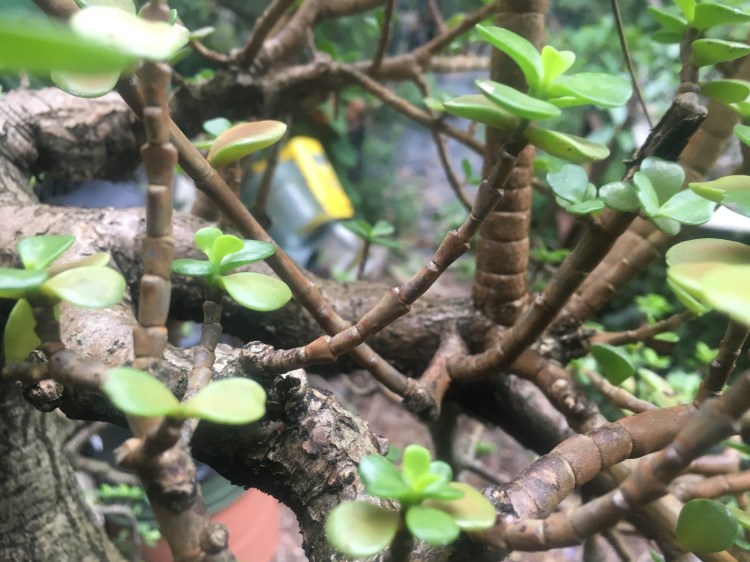
As you see, the growth is pretty strong. 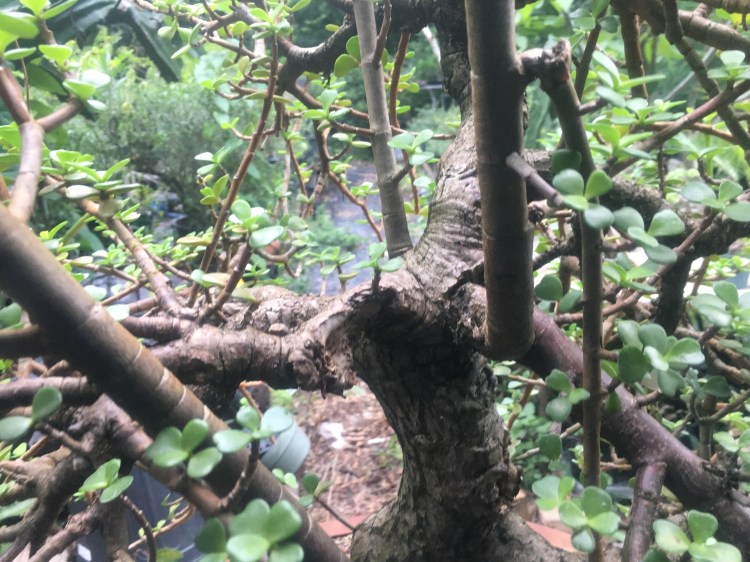
Most of it doesn’t fit into the design though, so……goodbye!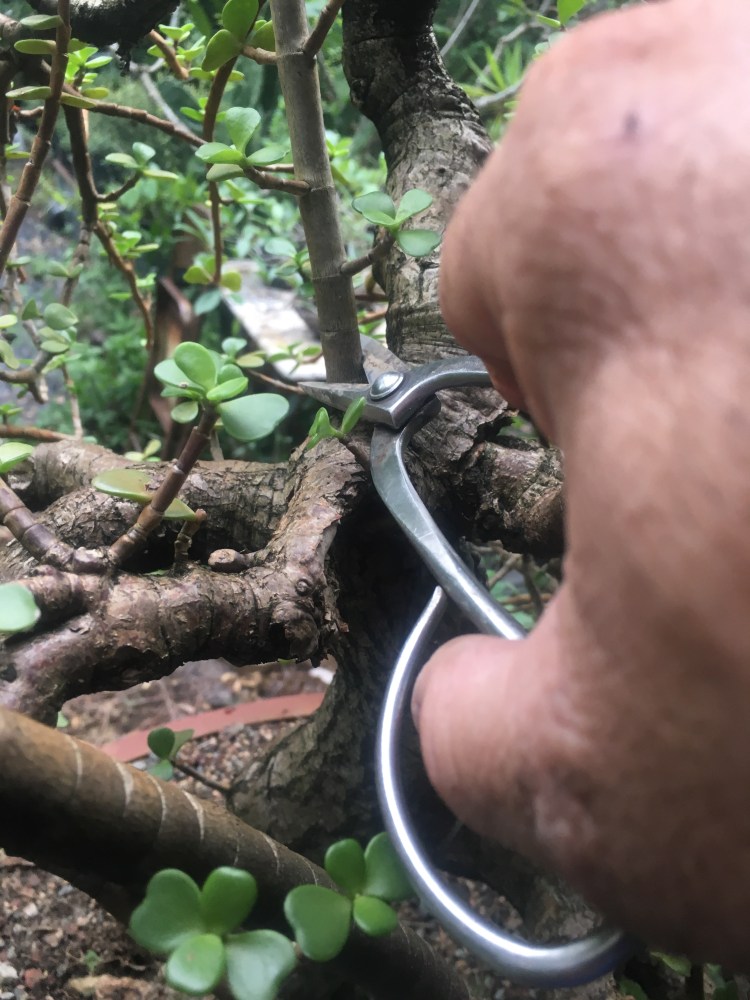
Look closely at the pics: observing how a port (or any tree) grows wildly will help you to develop a good tree in the long run. 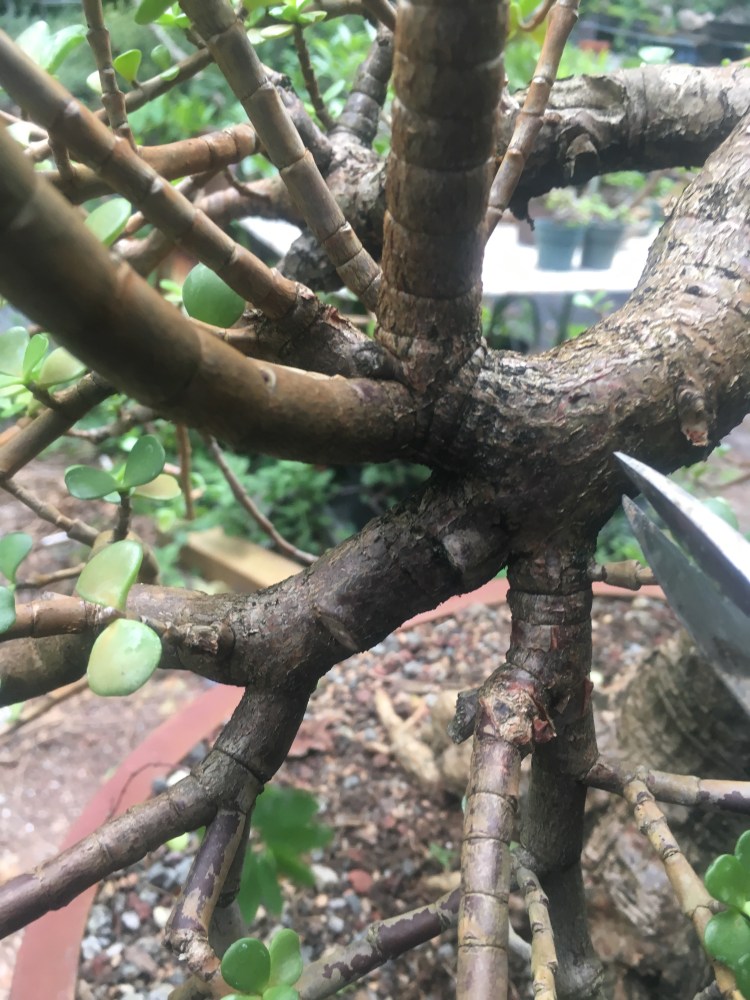 Wild growth is straight up, mostly.
Wild growth is straight up, mostly.
But some branches weep. Now, it might they are weeping because of all the suffering in the world, but probably it’s just sunlight and hormones. And a little to do with turgidity, hydraulic capacity and cell wall rigidity. 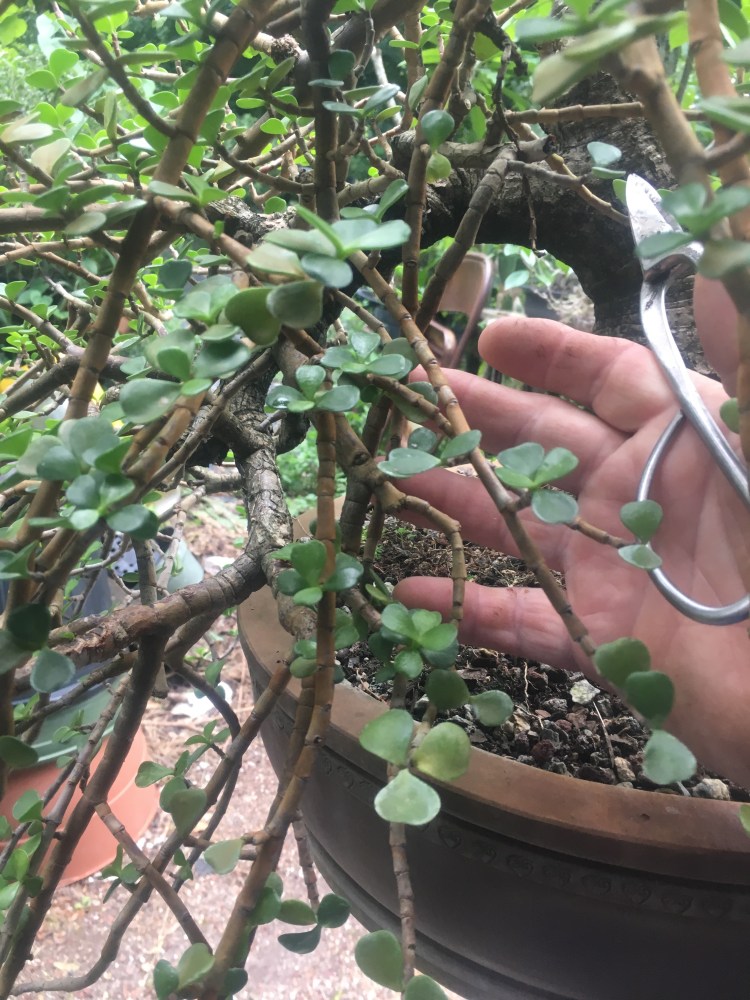
Now is the time for the tough choices. 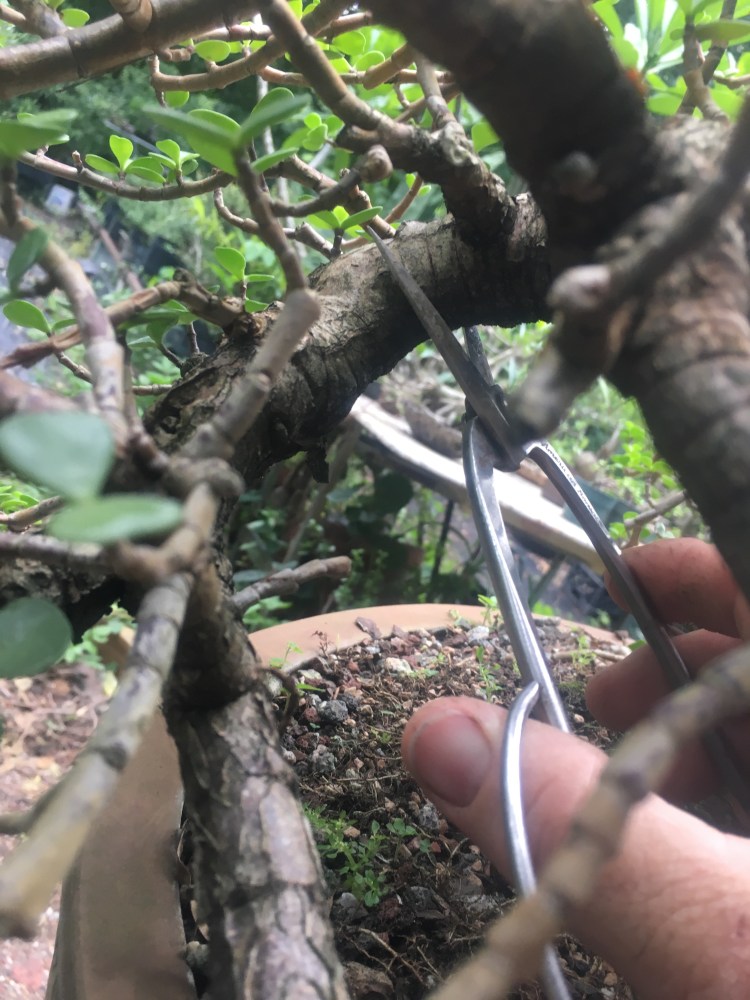 Wait!! What?!?!
Wait!! What?!?!
I did. I chopped it. 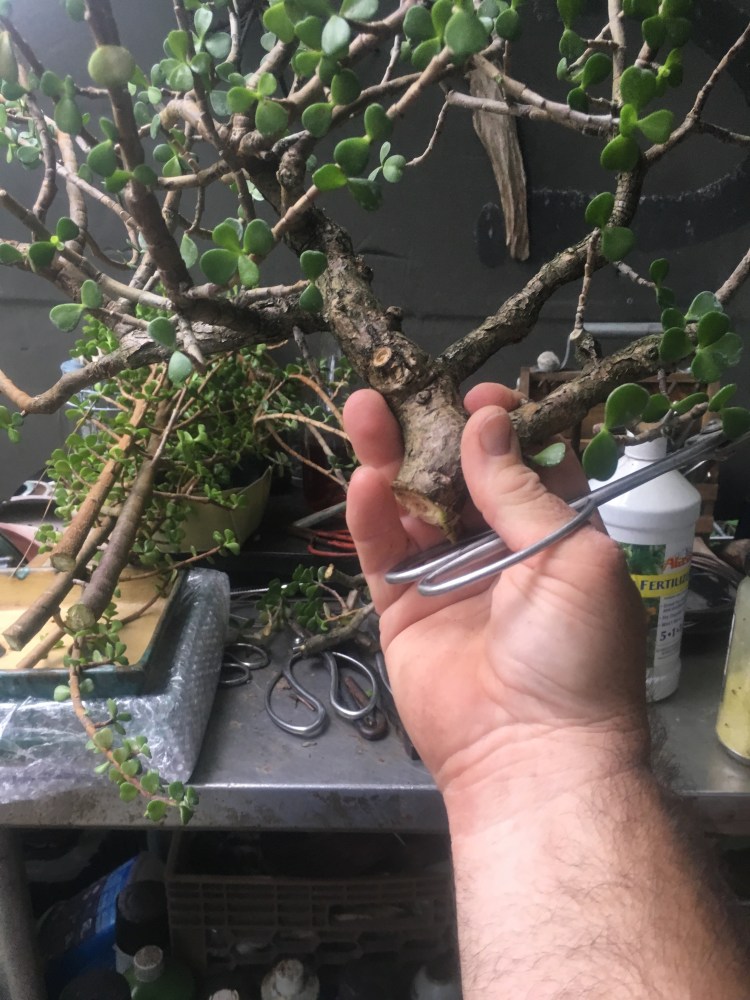 Not only that but it’s a chop-a-delic massacre!
Not only that but it’s a chop-a-delic massacre!
Enough for a crop of cuttings I must apologize. I know there are some readers out there that have trees smaller than the branches I just removed and there’s a certain anxiety in seeing the mayhem I’m visiting upon this poor tree.
I must apologize. I know there are some readers out there that have trees smaller than the branches I just removed and there’s a certain anxiety in seeing the mayhem I’m visiting upon this poor tree.
But sometimes you Just gotta start the game over. 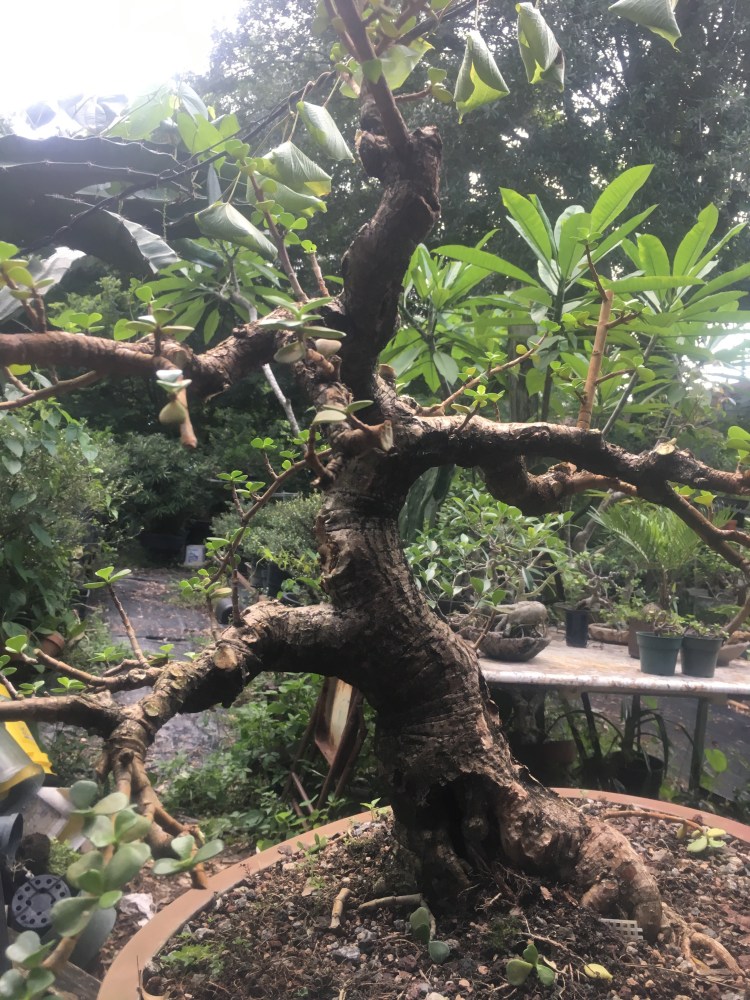
The top has a good leader. It can stay as it’ll draw the growth up. Well, maybe. 
The main branches have good taper and a gnarly character. 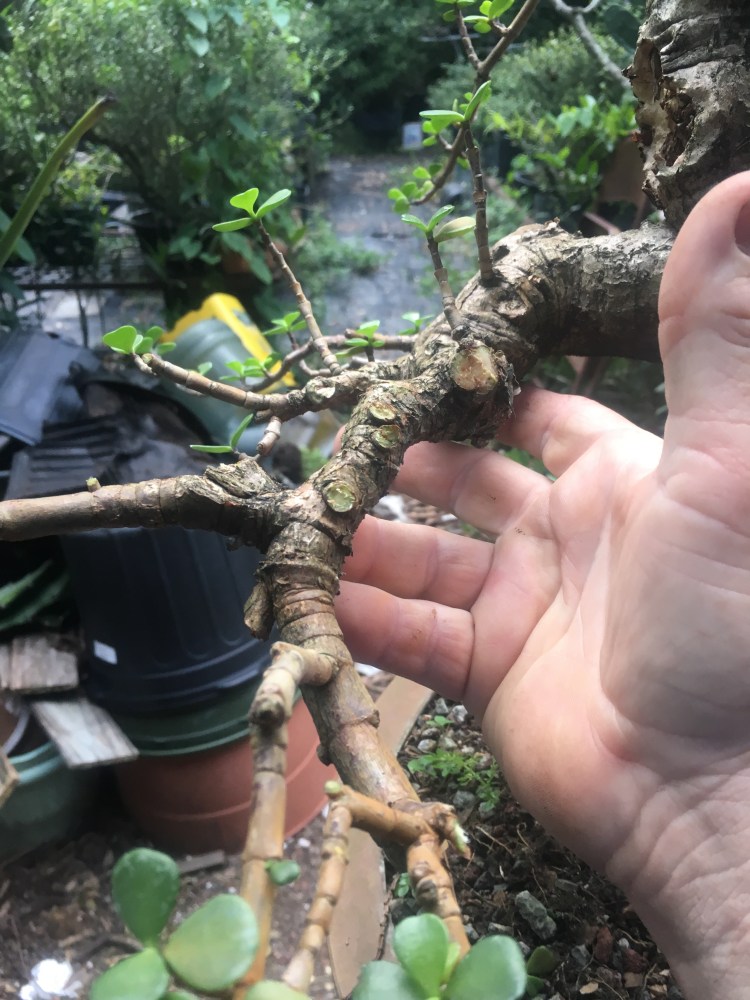
I am keeping some of those long shoots. Well, for now. 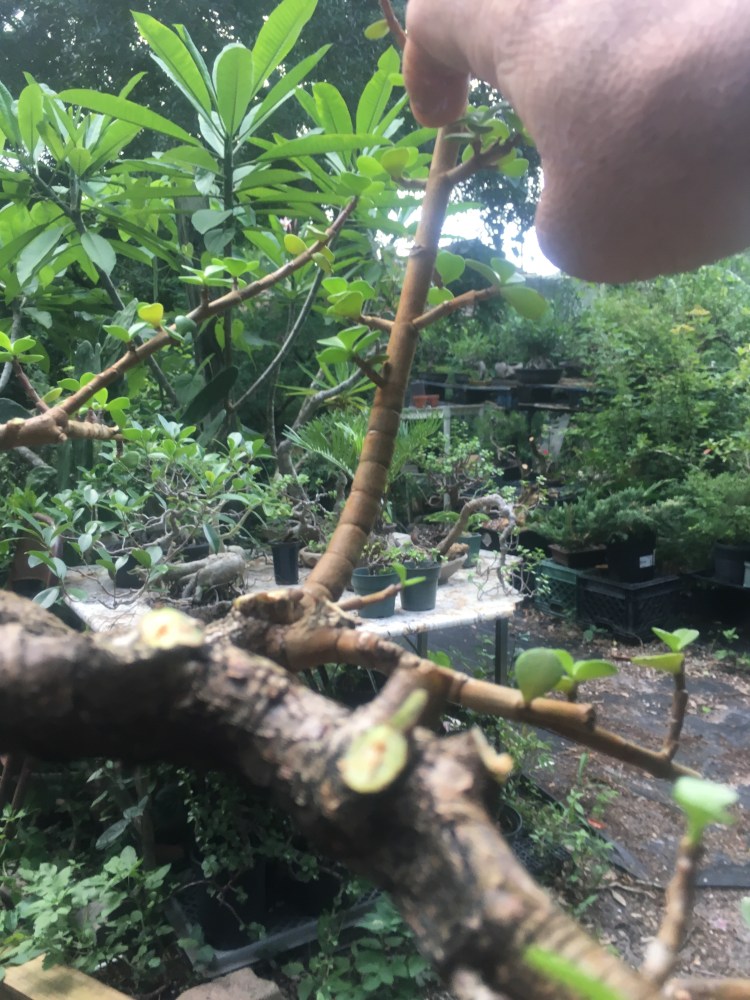
The next step is to change the front a bit. 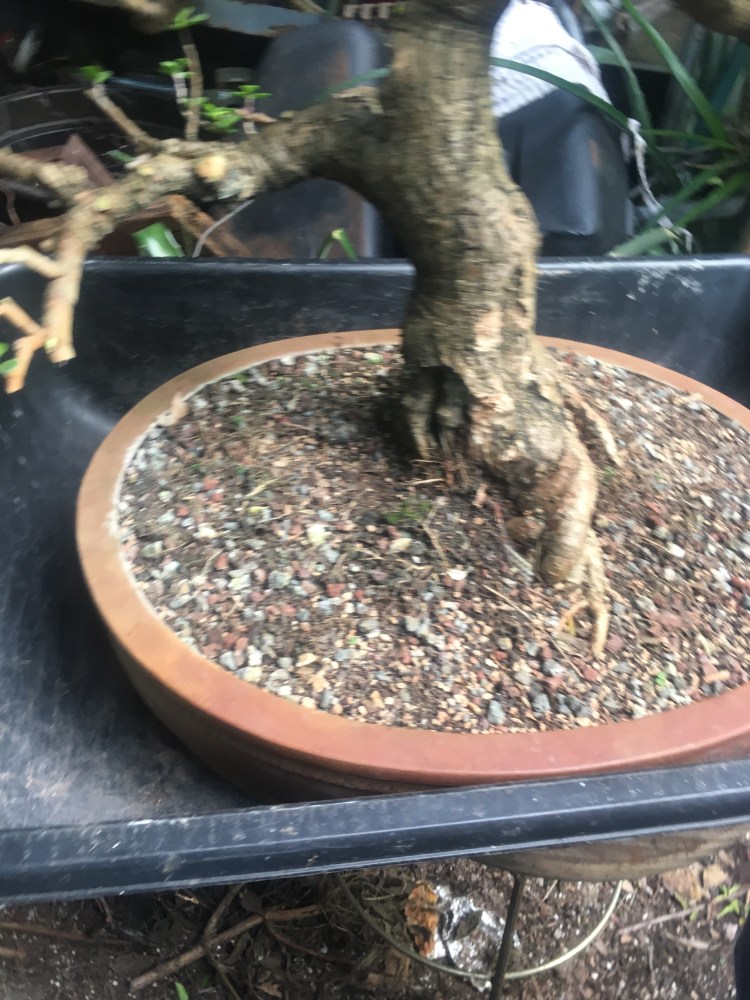 The current front is the above pic. That big root is pointing right at you. When I first started in Bonsai, a long time ago, it was taught to me that roots or branches on a bonsai that are pointing at the viewer are a no-no. Called, un-ironically, “eye pokers”. Me, of course, being the anti-authoritarian, cuss that I am, asked,
The current front is the above pic. That big root is pointing right at you. When I first started in Bonsai, a long time ago, it was taught to me that roots or branches on a bonsai that are pointing at the viewer are a no-no. Called, un-ironically, “eye pokers”. Me, of course, being the anti-authoritarian, cuss that I am, asked,
“Why?”
The answer that was presented to me was, in Japanese culture, to point at a person is considered rude.
Hmmmmmmnnnnn.
I think in every culture that’s considered rude.
The real reason we don’t like eye pokers is that you can’t see them. You see just the single point, well, POINTING at you. There’s no taper, no movement, no nothing.
Art, Bonsai, is a visual thing. If you can’t see it, it has no impact.
Therefore, on a branch, bend it so you can see it, on a root, twist it in the pot. If there is a cool bend in the trunk, it might be better to position the trunk so you can see it.
And with that…
Look as those roots!
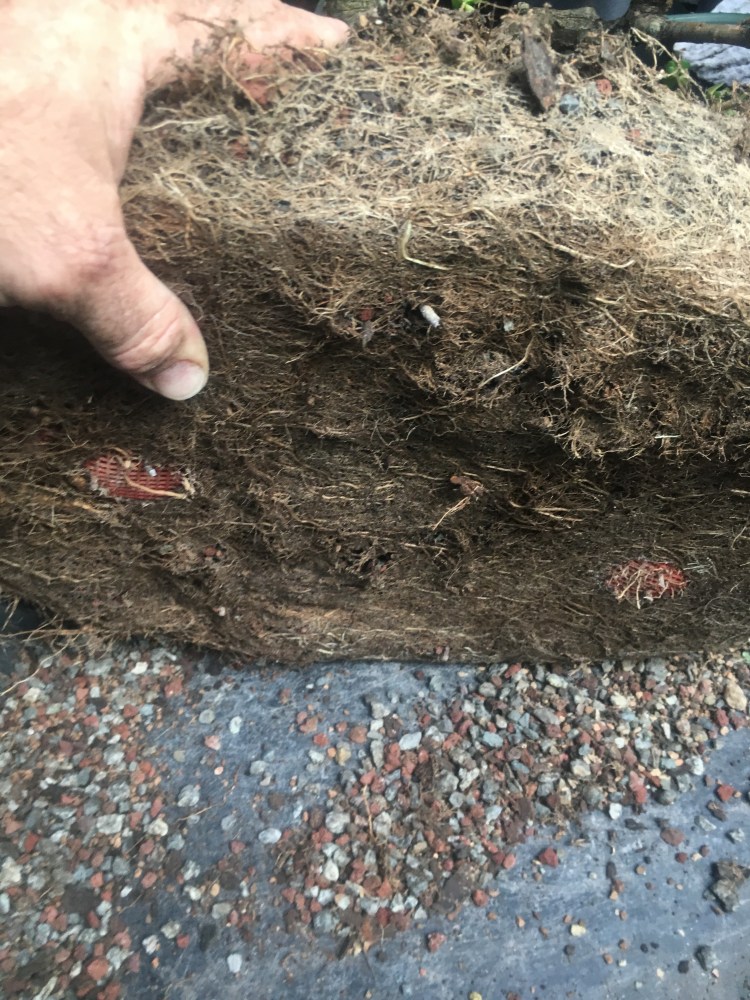 The technique with portulacaria is that we don’t need to rake out and bare root the tree every time we repot it.
The technique with portulacaria is that we don’t need to rake out and bare root the tree every time we repot it. 
Just a gentle combing of the winding and terminal roots ends so they grow radially from the trunk. I prefer a single tined rake for that reason. 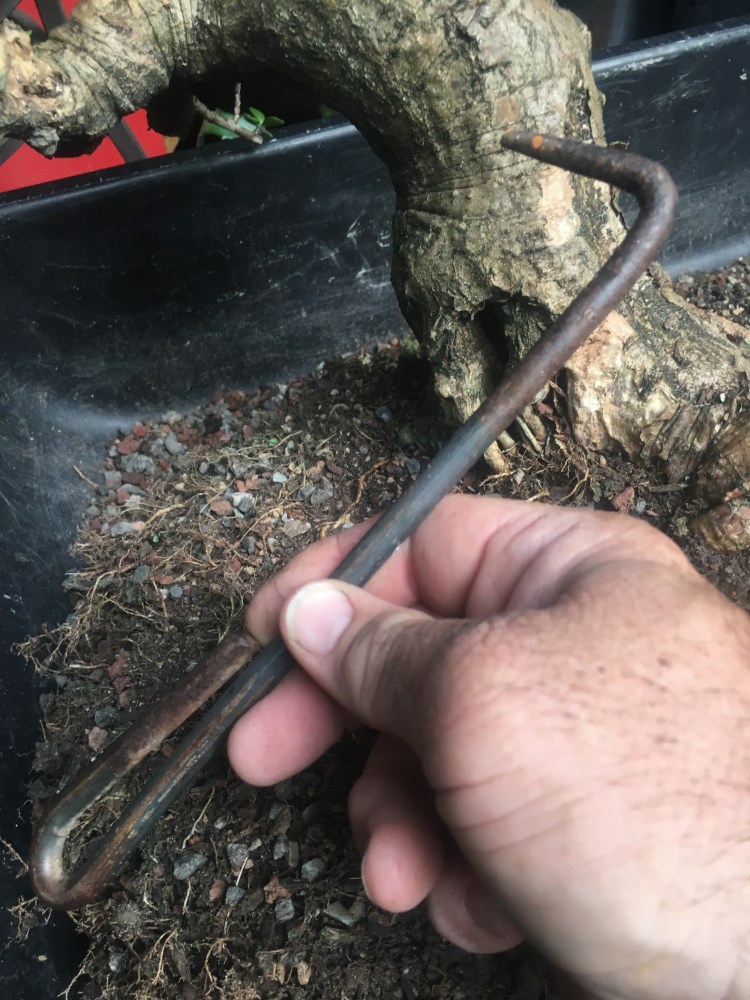
I don’t even like to cut heavy roots back like you’d do on any other tree. Sometimes you need to though. 
Like hither. 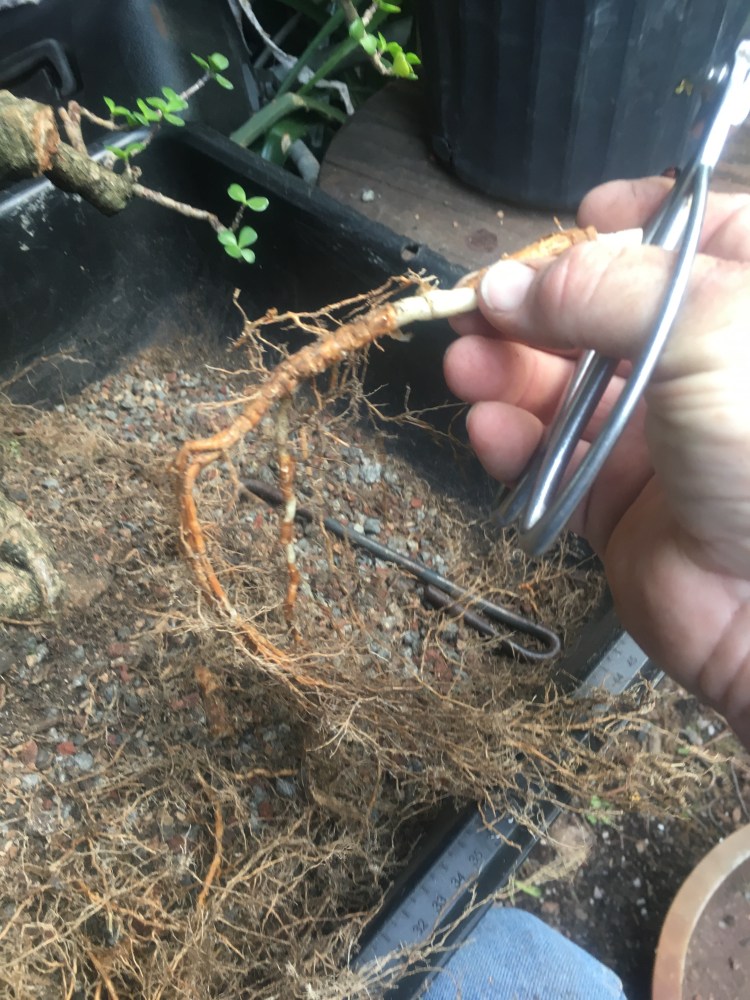
I will throw a little of the previous soil, sifted of course, back into the pot. I’ve observed mycorrhizae in a portulacaria root system and that’s a good thing. 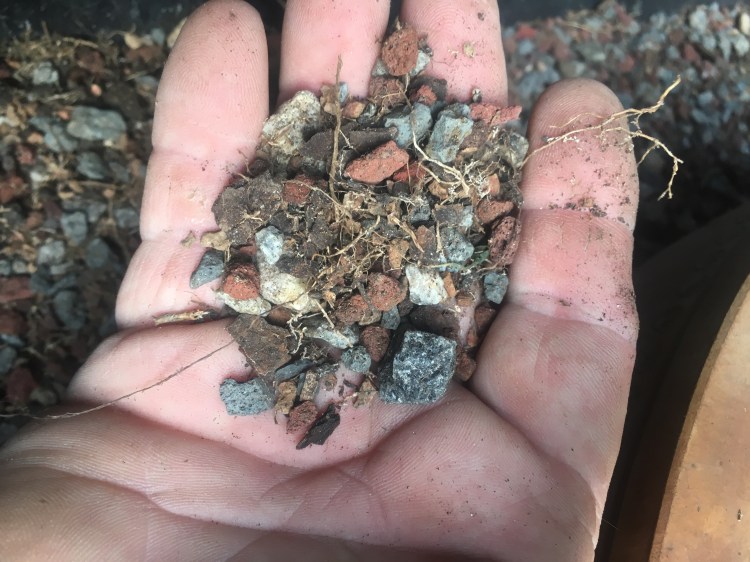
Tied in snug….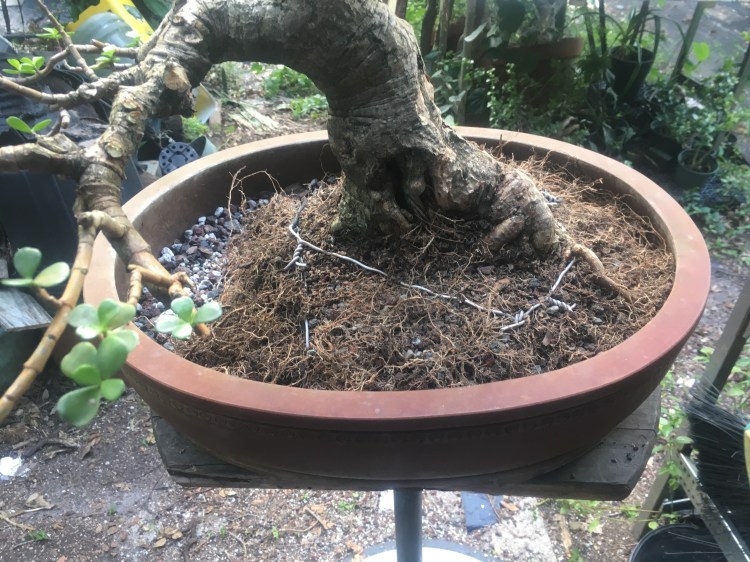
Backfilled with well draining soil. 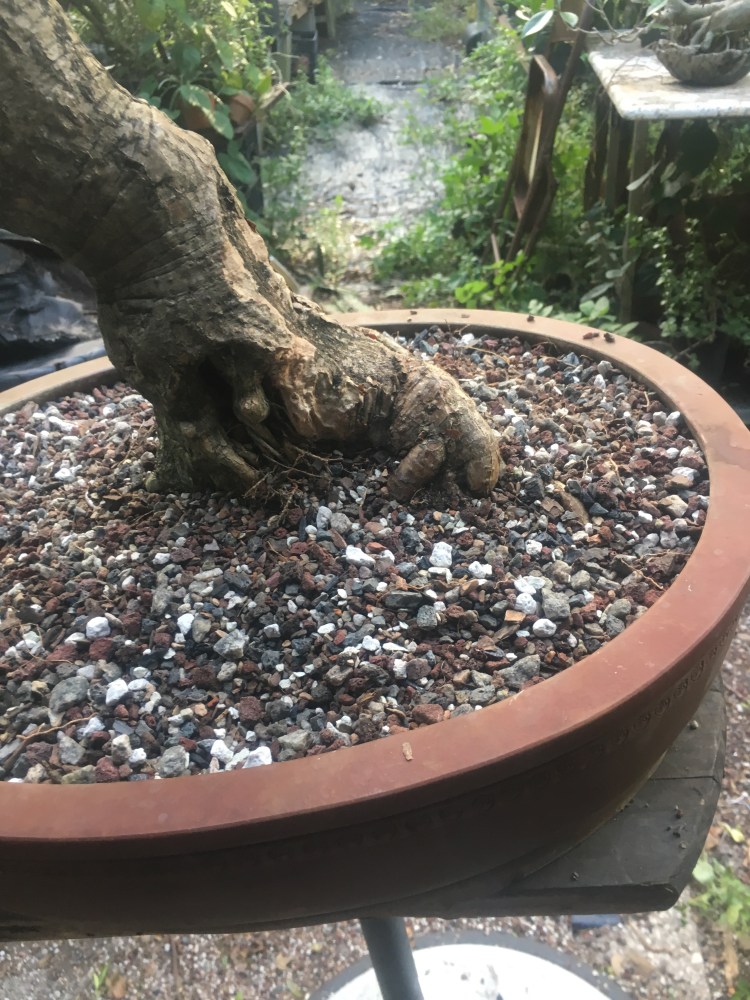
I prefer a granular, time release fertilizer for portulacaria (and all succulents really) because they tend to not hold much moisture and the high nitrogen pushes growth. 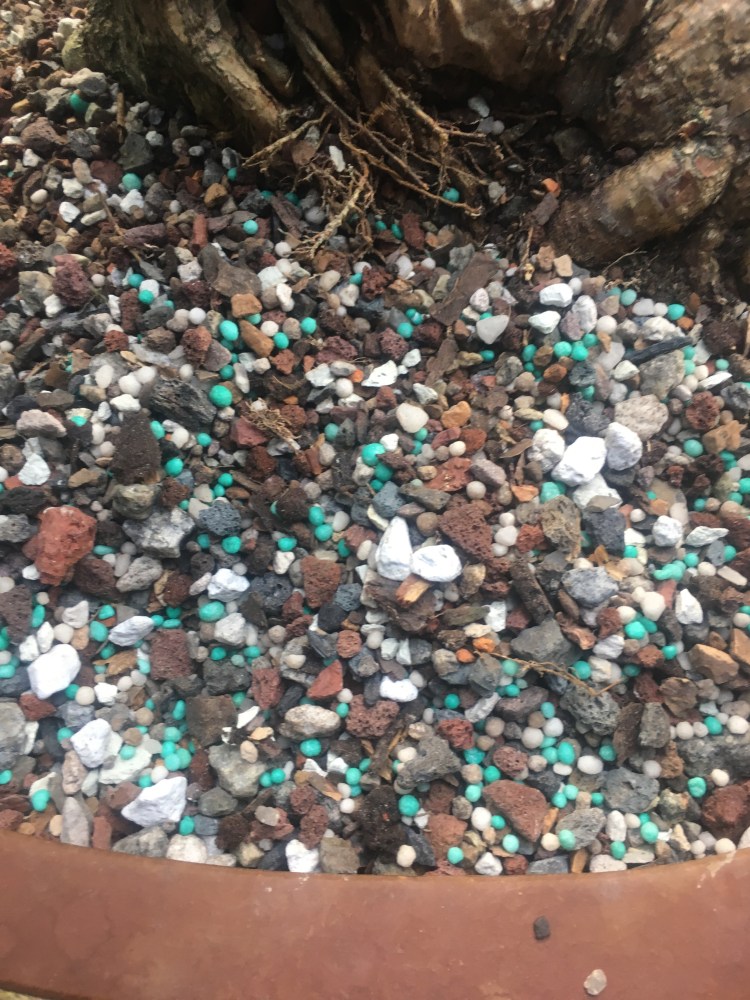
And of course, the pre emergent weed preventer.  I’ve had a few discussions recently about pre emergents. They work by inhibiting the germination of weed seeds. Some people are afraid of it because they think it’s some evil chemical that is unnatural and synthetic. Truthfully, everything is a chemical. So when I say “hormone” or “nutrient” what I’m really saying is “chemical”.
I’ve had a few discussions recently about pre emergents. They work by inhibiting the germination of weed seeds. Some people are afraid of it because they think it’s some evil chemical that is unnatural and synthetic. Truthfully, everything is a chemical. So when I say “hormone” or “nutrient” what I’m really saying is “chemical”.
The companies that developed the pre emergent treatments looked at trees that naturally had few weeds below them. They took the leaves, the stems, the roots, the fruit, and the seeds, and experimented until they found the compound that inhibited foreign seed germination. Then they figured out how to make this compound, how to apply it, and now they sell it.
And it works. The process is to remove all existing weeds. Wait a week or two and remove the weeds that grow in that time (you missed some, admit it). Then apply the pre emergent (a good name brand is Preen). The secret is, every time the soil surface is disturbed, re apply the product.
The way it works is the hormone that prevents germination creates a barrier or film on the soil surface. If you disturb that barrier, you’ll get weeds.
Anyway, back to the tree.
A little wire…
Except on the wee little branches (which will grow quickly now) 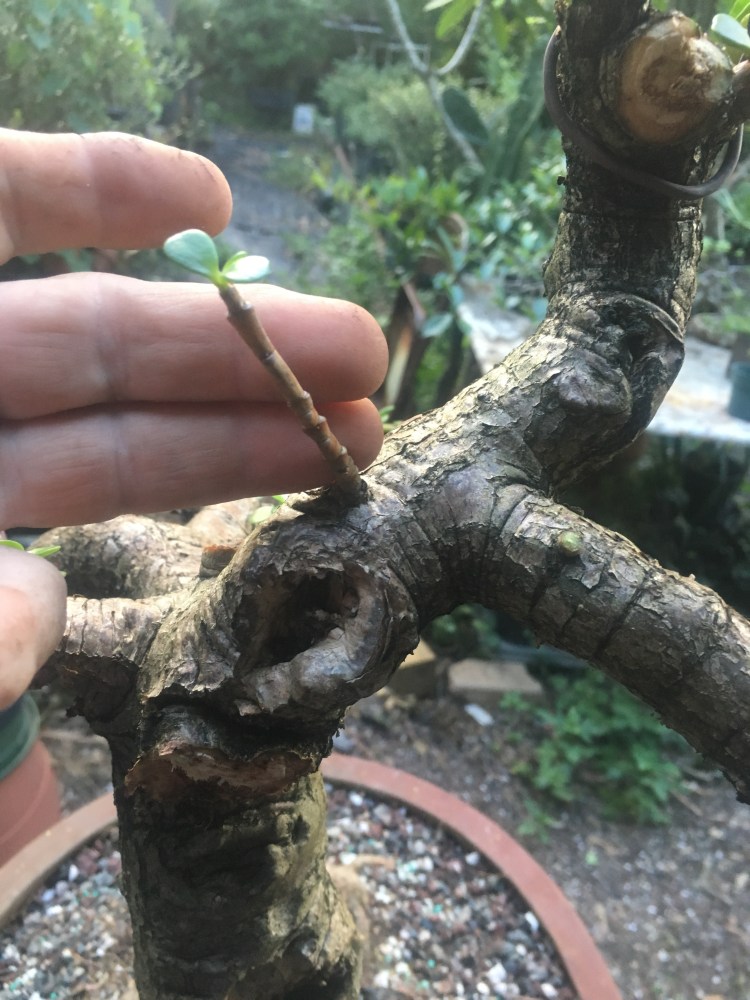


A few adjustments and….
This tree will stay under cover for about a week, so that those few places I cut in the roots have a chance to dry out and scab over. This prevents rot in the root zone.
The hardest part about these trees is the repot. Be gentle, don’t water for at least a week, and then sparingly until you get new growth. 
And Bob’s yer uncle!
Thank you for this! I have seemingly hundreds of these growing in various pots around my house because I don’t like throwing away cuttings. I literally just googled the species today to try and see if anyone uses it as bonsai material. Such an interesting coincidence that you posted about this plant.
LikeLiked by 1 person
Been waiting a Port post for a while. Thanks! Would love to see some update pictures on some of your others. Great work on the subject tree too — it looks like it’s got a great future.
LikeLike
Adam,
1. How “full” of leaves should a portulacaria be to be healthy? I have been nursing one back to health since I got in March; it was overwatered with no light and had very few leaves. Now it has a lot more leaves, but is pretty sparse compared to others I have seen. However, in this post this tree started out fairly sparse. Is the density of foliage more to do with bonsai techniques rather than health of the tree?
2. Where I am (Nebraska), my tropicals will have to come inside sometime this week. Is that a good time to repot and work them, since they will have to adjust to the new light anyway? Or should I wait for May when I take them back outside?
LikeLike
very informative, Thanks Sensei
LikeLike
Adam, I heard somewhere that the only real way to develop a decent nebari on a succulent was to keep the roots pruned back to a flat apron emerging from the base of the trunk. Is there any truth to that at all?
LikeLike
As with most horticultural techniques, there’s more than one way to do things.
Those who claim to have the “only” way tend towards an en elitism that has no place in Bonsai.
You can allow it to get pot bound and then put in a bigger pot, you can spread out the roots carefully every time you repot, you can even chop the entire root mass off and suspend the trunk about a quarter inch off the soil surface and new roots will emerge, reaching for the soil.
LikeLike
Adam, hope you weren’t too effected by Dorian. I was there for the last Cat 5. I love this post!! I still don’t have the hang of posting on a blog, especially pictures, so I’m going to send them here. Don’t know what’s going on. The Bonsai was doing ok, new growth started coming in, leaf drop was minimal, started lightly pruning because I don’t know what shape to give it. I wanted it to be a weeping Bonsai (never pruned) & it did well outside with bright light on my patio in FL. Now it’s in Seattle weather, inside near bright light, I try to put it in the sun in the am, if there is any. It was over a month so decided to fertilize lightly. But I think it has a fungus. Old & new growth is dropping. I’ve been doing so much research on pests, I think these are scales but it has black spots too. I treated each spot with a QTip w alcohol. Was going to buy what you recommend ‘tebucanazole’. Can you take a look at the pics (I have to send them separate), they show both the dropped leaves & what’s on the Bonsai. Thank you for your help, Denise
>
LikeLike
I have been devouring your blog and it is very different than the normal bonsai instructions. One of the main differences is that you fertilize immediately after any work is done. Am I seeing that right? If I am it is obviously working for you, what is the main reason you do fertilize right away and almost everyone else says to wait until a certain time period or a certain phase in the plants recovery. thank you for the blog you have the most fun and rebellious attitude I’ve seen and I really enjoy it.
LikeLike
A trees roots need fertilizer as they grow, even new ones.
The rationale for not fertilizing after a repot is that the fertilizer will burn new roots. But a tree is continually creating new roots, so if the whole burning is correct, when are we able to fertilize?
I think the reason they say not to fertilize after a repot is someone over fertilized one time (or habitually does) and incorrectly extrapolated that fertilizer was bad when it was their over fertilization that killed the tree
LikeLiked by 1 person
I never thought of it that way, it makes sense. Thanks for the reply!
LikeLike
Nice
On Wed 11 Sep, 2019, 3:23 AM Adam’s Art and Bonsai Blog, wrote:
> adamaskwhy posted: “The portulacaria afra is known by many names, for > example, even way down in South Africa, where they are native, they have a > few names: spekboom, or porkbush, or even elephants food. In the succulent > community they call it (inexplicably) dwarf jade, even ” >
LikeLike
Wooooooowwwww
Just to be loved, nothing else.
ps
What do you think about cycads? (bonsai cycads that is)
LikeLike
They have their place in bonsai. There are some amazing ones in Japan
LikeLike
Do you have any?
LikeLike